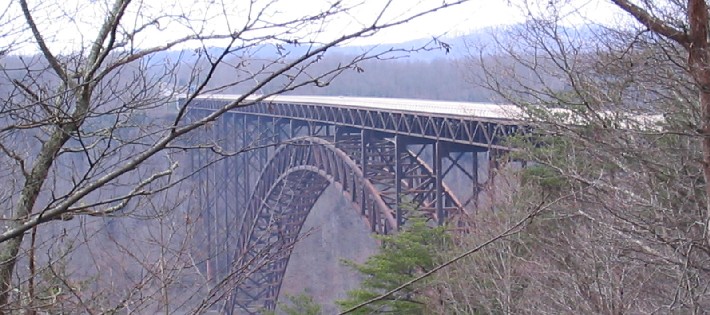
Members of the Civilian Conservation Corps help construct the Skyline Drive in Shenandoah National Park (Image from the National Park Service's online pamphlet, "Highways in Harmony: The Skyline Drive")
This evening I typed the word “trail” into my computer and cranked up the electro-whiz-bang thesaurus. Soon thereafter that rare breed of ancient reptile vomited, ahem, “path, track, way, road, footpath, route, footprints, footsteps, trace, imprints, marks, trajectory, stream, and line” and so on. Why, you ask, was I looking for synonyms of said term? To make you ask questions.
Okay, that and because I was looking for inspiration. How should I start my blog entry on the subject of trails in Appalachia? I thought about talking the big talk about how trails, whether they are institutionalized or not, are the physical manifestations of our progress in life. I considered quoting well-known quips, “getting there is half the fun,” and what have you. Heck, I considered posturing cleverly, citing cyclopean monstrosities from The Odyssey and dog-headed men from The Travels of Marco Polo and the occasional demon in the Inferno and a whole host of other fictional and non-fiction travelogues. But what I decided to open with was a different tack, an alternative salvo. What I settled on, though, were pilgrimages.
A pilgrim is defined as a religious devotee who travels to a shrine or holy place, a traveler who is attempting to fulfill some sacred quest. Their quests draw meaning from two different elements. On the one hand, a pilgrim seeks to arrive at a destination, a place that holds intrinsic symbolic value. On the other hand, a point often forgotten these days, the process of moving from one’s home to his destination carries value in and of itself. Ideally, the process of moving from point A to point B (often interspersed by a series of holy places) is a mystical process, a symbolic progression from normality to, well, something special, something different. After traveling down the trail of a pilgrimage, a pilgrim is meant to be transformed – he or she is reborn, metaphorically or literally. In pilgrimages, our homes are the wombs, and the trails, well, they are our birth canals, squeezing and pushing us until suddenly we have the ability to take the free air at our destination.
All of that said, Appalachia is a place known for its trails. Some of these follow the lines of the mountains themselves, others their valleys, tracing the outline traced by the Deity when continents collided before things that flew had feathers or things that walked had hair. Some of them follow the paths of our ancestors – some of whom were fleeing something, some of whom were seeking liberty, some of whom were literally dragged in chains, and some of whom were driven from land they had farmed and built upon and fought for over uncounted centuries. Some of our trails trace the evolution of the American culture, the convergence of European, Asian, African, and native American physical and artistic cultures, the birth of food cultures and musical cultures and language cultures from incredibly ancient roots.
I want to bring a few of these trails to your attention, and I have a couple of motives. Sure, I think they’re interesting. And yes, I want to encourage tourism in Appalachia, especially in areas, um . . . off the beaten path. Oi. But beside that I want to encourage a discussion. What other pilgrimages should we Appalachians have, where else should we carve trails, or merely reinvigorate those that already exist? Add’m to the commentary and I’ll update this entry accordingly. . . .
The Appalachian Trail
Appalachian Long Distance Hikers Association
Appalachian Trail Conservancy
Appalachian Trail Museum Society
National Park Service on the AT
Natural Bridge Appalachian Trail Club
Update! (Thanks to
Mike Mason)
Piedmont Appalachian Trail HikersPotomac Appalachian Trail Club
Purebound on the AT
Roanoke Appalachian Trail Club
Trail Journals
Wikipedia
The Blue Ridge Music Trail
The Blue Ridge Music TrailThe Blue Ridge Parkway
Blue Ridge Parkway Guide
The National Park Service on the Blue Ridge Parkway
The Coal Heritage Trail
The National Coal Heritage Area
Wonderful West Virginia, “Coal Heritage Trail”
The Crooked Road
The Crooked Road: Virginia’s Heritage Music Trail
The Roanoke Times, “Going Down the Crooked Trail”
Virginia.org, “The Crooked Road: Virginia’s Heritage Music Trail”
The Washington Post, “Twists and Twangs: Virginia Plots its Musical Heritage Along a ‘Crooked Road’”
The Hatfield & McCoy Trails
Hatfield & McCoy Trails
The New River Trail
The New River Trail Virginia State Park
The Midland Trail
The Midland Trail National Scenic Highway
Wikipedia
Skyline Drive
Mile by MileThe National Park Service's "Highways in Harmony: The Skyline Drive"Skyline Drive Historic DistrictWikipediaThe Trail of Tears
National Trail of Tears Association
North Carolina Chapter of the Trail of Tears Association
Tennessee Chapter of the Trail of Tears Association
Sarah Vowell on This American Life
Trail of Tears National Historic Trail
Wikipedia
Washington Heritage Trail
The Washington Heritage Trail
Washington Heritage Trail in Morgan County
West Virginia Hiking Trail Itineraries
The Wilderness Road
Daniel Boone Wilderness Trail Association
Wilderness Road Virginia State Park
Wikipedia



















 Asheville Area Music Scene
Asheville Area Music Scene

































